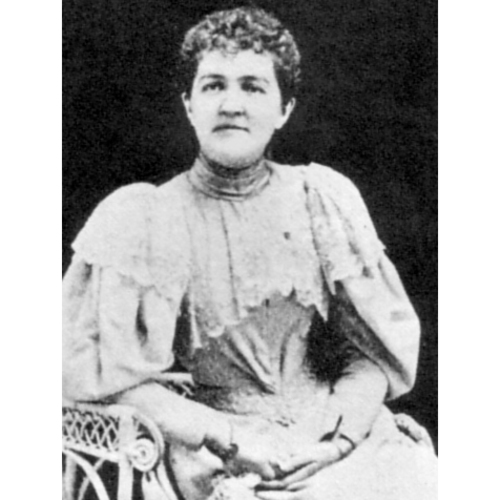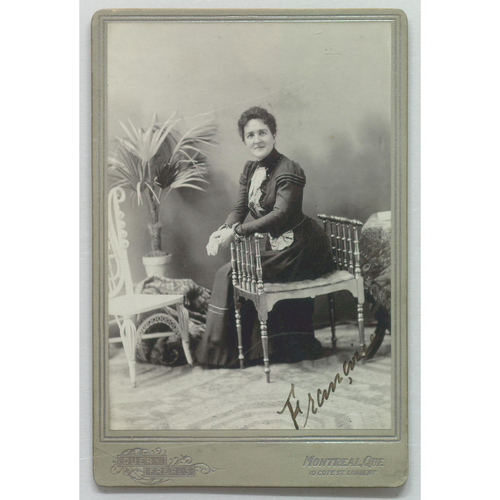
Source: Courtesy of Wikimedia Commons
BARRY, ROBERTINE, known as Françoise, journalist, writer, lecturer, feminist, and office holder; b. 26 Feb. 1863 in L’Île-Verte, Lower Canada, daughter of John Edmond Barry and Aglaée Rouleau; d. unmarried 7 Jan. 1910 in Montreal.
Robertine Barry’s father, a native of Ireland and descendant of a distinguished family, came to Canada in the mid 19th century. He began his career in the lumber trade by working in the shanties of William Price*. Bilingual and well educated, he soon rose to prominence in the Saguenay region, and he held various administrative posts (mayor, jp, and small claims commissioner) along with such honorary offices as vice-consul of Sweden and Norway.
A good and devout woman, Robertine’s mother was born in L’Île-Verte and raised her 13 children with the help of “old Cécile,” the family’s faithful housekeeper. An anecdote popularly known as “the crinoline affair” gave Aglaée Barry a place in history. On 11 Aug. 1861 in Les Escoumins she came to church in a dress with a crinoline, only to be refused communion at high mass. It took the intervention of the archbishop and the appointment of a new parish priest to bring the incident peacefully to a close.
As the daughter of a good family, Robertine Barry enjoyed the best education available to a young girl. After attending elementary school in Les Escoumins from 1868 to 1873, she entered the Couvent Jésus-Marie in Trois-Pistoles as a day pupil. From September 1880 to July 1882 she was a boarder with the Ursulines in Quebec. The student newspaper “L’Écho du cloître” contains six pieces by the future journalist: two in the 1880–81 volume and four in the 1881–82 one.
In 1891, nine years after her graduation from school, Robertine Barry, thenceforth known by the pen-name of Françoise, wrote her first pieces for La Patrie of Montreal. A Liberal and radical paper of which Honoré Beaugrand was then editor, between 30 April and 16 June it carried four articles by her on education. Then came a series of three stories which, in 1895, were included, with a dozen others, in Fleurs champêtres, her first published book. Highly praised by the press, the book touched off a memorable war of words between Barry, Joséphine Dandurand [Marchand*], and Louis Fréchette on the one hand, and Jules-Paul Tardivel on the other. Tardivel, the redoutable editor of La Vérité (Québec), thought the journalists with whom Françoise worked at La Patrie were having a bad influence on her, and he accused her of overworking superstition, painting an unflattering picture of country folk, neglecting “the religious element,” and imitating the style of Jean-Jacques Rousseau. Her good friend Fréchette, who by then was a seasoned veteran of polemical battles, took verbal aim with deadly accuracy. Tardivel could only retort lamely with comment on the spelling in his opponent’s article. From then on, Françoise held a special place in the literary circles of the day. Around 1898, she even began to dispense advice to Émile Nelligan*. She became his “sister in friendship,” as he described her in Rêve d’artiste, one of the five poems that she inspired or were dedicated to her.
From 21 Sept. 1891 to 5 March 1900 her “Chronique du lundi” appeared on the front page of La Patrie. The form of these weekly articles remained typical of a social column: writing in the first person, the narrator informed and educated her readers by discussing this and that. Using a conversational tone, Françoise employed various devices (a mix of genres, digressions, statistics, anecdotes, and quotations, for example) to lead her readers to a conclusion, often unexpected, humorous, and allusive, which made them stop and think. The innovative aspect of the “Chronique du lundi” lay elsewhere: it was the work of a woman who did not address women alone, and who, not dealing exclusively with feminine subjects, expressed modern, sometimes unsettling ideas on the nature and status of women. In 1900 she herself published a collection of 87 of her articles that had appeared in La Patrie between 1891 and 1895, entitling it Chroniques du lundi. At the same time, she had a hand in writing “Coin de Fanchette,” the paper’s weekly women’s page, for which she penned her “Réponses aux correspondants” from 13 Feb. 1897 to 6 Aug. 1898. She thus ushered in the era of the “lonely hearts column” in the province of Quebec. Subsequently, her contribution to this Saturday page was a chatty column entitled “Causerie fantaisiste,” which ran from 10 Sept. 1898 to 10 March 1900. She closed her career at La Patrie with a series of letters addressed to both women and men during her stay in Paris from April to September 1900 for the universal exposition. Each appeared under the title “Lettre de Françoise.”
During the years at La Patrie and even afterwards, Françoise also wrote for many other Montreal publications: Le Coin du feu, Le Bulletin, Le Franc Parler, La Femme, La Revue populaire, Revue canadienne, Le Samedi, L’Album universel, La Kermesse, La Charité, Almanach du peuple, La Revue nationale, and La Feuille d’érable. Her contributions to these periodicals were not extensive: only a few articles in each, at most a monthly piece in La Revue nationale in the year from February 1895 to January 1896.
Robertine Barry’s major work as a journalist, in terms of both quantity and quality, is Le Journal de Françoise, a bimonthly she founded and edited. Published from 29 March 1902 to 15 April 1909, it had among its contributors writers of the first rank, including Laure Conan [Félicité Angers*], Joséphine Dandurand, Marie Gérin-Lajoie [Lacoste*], Juliette Adam, Émile Nelligan, Louis Fréchette, Albert Lozeau*, and Jules Claretie. The magazine offered a variety of features intended mainly, but not exclusively, for women.
As a Montreal personality, Françoise had demands made on her from all sides and, with apparent pleasure, lent her nom de plume, her articles, and her eloquence to charitable causes. Her name was on guest lists, she headed subscription campaigns, she served as a patroness of charity fairs and bazaars, and she called for public libraries to be set up. Social action was a favourite theme of the many lectures she gave far and wide, in which she demanded better living conditions for children, the elderly, and women. This stand would establish her as one of the leading lights of feminism in Quebec during her time. From 1900 “Mlle Françoise” became sufficiently well known to garner a number of honours: she was appointed with Joséphine Dandurand to represent Canadian women at the universal exposition in Paris in 1900, she contributed a chapter, entitled “Les femmes canadiennes dans la littérature,” to a book distributed during the fair, and she participated in the International Women’s Congress. In 1904 Françoise received from the French government the title of officier d’académie, and she was one of 16 women journalists sent to the Louisiana Purchase exposition in St Louis, Mo., by the Canadian Pacific Railway [see George Henry Ham*]; the trip resulted in the founding of the Canadian Women’s Press Club. Two years later she represented Canada at the universal exposition in Milan. Only a few months before her untimely death, the Liberal premier of Quebec, Sir Lomer Gouin*, appointed her inspector of women’s working conditions in industry.
Robertine Barry was an important figure in the history of Canadian feminism and of 19th-century Canada. A modern, professional woman, single and independent, she gave the press of her time a new mission: to provide a platform, not just for the endless wars between Rouges and Bleus, but for all the women and men interested in culture generally and in the greater well-being of all.
[Using the pseudonym Françoise, Robertine Barry wrote four articles for La Patrie: “À propos d’éducation,” 30 avril 1891; “De l’instruction des jeunes filles,” 13 mai 1891; “Encore de l’éducation,” 21 mai 1891; and “Toujours de l’éducation,” 16 juin 1891; as well as three stories: “Le mari de la Gothe,” 20 juill. 1891; “Trois pages de journal,” 10 août 1891; and “La douce,” 31 août 1891. Other works, also published under the pseudonym Françoise, are Chroniques du lundi (Québec, [1900]); Fleurs champêtres (Montréal, 1895; 2e éd., 1924); and “Les femmes canadiennes dans la littérature,” which appeared in Les femmes du Canada: leur vie et leurs œuvres (s.l., 1900), after having been published in La Patrie on 18 May 1896 as “De l’influence de la femme dans la littérature.” Gilles Lamontagne edited some of Françoise’s works in “Fleurs champêtres,” suivi d’autres nouvelles et de récits et “Méprise,” comédie inédite en un acte (Montréal, 1984).
Other pieces by Françoise are held in a number of archival repositories. ANQ-SLSJ, Coll. Mgr Victor Tremblay, SHS, doc.492, pièces A–K, and dossier 1328, pièces 1–29, include various letters and texts of lectures and of “Méprise” and other articles. The Centre de Recherche en Civilisation Canadienne-Française at the University of Ottawa has three of Robertine Barry’s pieces in the Fonds Albert Ferland (P 5/2/7) and one in the Fonds J.-E. Roy (P 79/1). The H. J. Morgan papers at NA (MG 29, D61) contain an interesting letter.
Aurélien Boivin’s article “Fleurs champêtres” in DOLQ, 1: 268–70 includes an extremely useful bibliography. a.c.]
AC, Montréal, État civil, Catholiques, Cimetière Notre-Dame-des-Neiges (Montréal), 10 janv. 1910. ANQ-BSLGIM, CE4-2, 26 févr. 1863. Bibliomane, “Fleurs champêtres,” Le Réveil (Montréal), 25 mai 1895: 202. Mme Raoul Dandurand [Joséphine Marchand], “Censure déloyale,” Le Coin du feu (Montréal), juillet 1895: 216–17; “Un nouveau livre,” Le Coin du feu, mai 1895: 155–56. L’Événement, 4 mai 1895. Le National (Montréal), 16 mai 1895. Georges Bellerive, Brèves apologies de nos auteurs féminins (Québec, 1920). Aurélien Boivin et Kenneth Landry, “Françoise et Madeleine, pionnières du journalisme féminin au Québec,” Voix et images (Montréal), 4 (1978–79): 233–43. Anne Carrier, “Françoise, pseudonyme de Robertine Barry: édition critique des ‘Chroniques du lundi,’ 1891–1895” (thèse de phd, univ. Laval, Québec, 1988). Gertrude Chassé, “Biobibliographie de Françoise (Mlle Robertine Barry)” (École de Bibliothécaires, univ. de Montréal, 1945). Raymond Desgagné, “Françoise (Robertine Barry), 1863–1910,” Saguenayensia (Chicoutimi, Qué.), 2 (1960): 73–75. Renée Des Ormes [Léonide Ferland], Robertine Barry en littérature: Françoise, pionnière du journalisme féminin, 1863–1910 (Québec, 1949). DOLQ, 1: 123. “Fleurs champêtres par Françoise,” Rev. canadienne, 31 (1895): 639–40. J. Hamelin et al., La presse québécoise, vols.2–4. Diane Thibeault, “Premières brèches dans l’idéologie des deux sphères: Joséphine Marchand-Dandurand et Robertine Barry, deux journalistes montréalaises de la fin du XIXe siècle” (thèse de ma, univ. d’Ottawa, 1981).
Revisions based on:
Sergine Desjardins, Robertine Barry (2v., [Trois-Pistoles, Québec], 2010–11), 1–2. Linda Kay, Sweet sixteen: the journey that inspired the Canada Women’s Press Club (Montreal and Kingston, Ont., [2012]). La vie littéraire au Québec, sous la dir. de Maurice Lemire et al. (6v. parus, Sainte-Foy [Québec], 1991– ), 4. Paul Wyczynski, Émile Nelligan: biographie ([Montréal], 1999).
Cite This Article
Anne Carrier, “BARRY, ROBERTINE, known as Françoise,” in Dictionary of Canadian Biography, vol. 13, University of Toronto/Université Laval, 2003–, accessed December 30, 2025, https://www.biographi.ca/en/bio/barry_robertine_13E.html.
The citation above shows the format for footnotes and endnotes according to the Chicago manual of style (16th edition). Information to be used in other citation formats:
| Permalink: | https://www.biographi.ca/en/bio/barry_robertine_13E.html |
| Author of Article: | Anne Carrier |
| Title of Article: | BARRY, ROBERTINE, known as Françoise |
| Publication Name: | Dictionary of Canadian Biography, vol. 13 |
| Publisher: | University of Toronto/Université Laval |
| Year of publication: | 1994 |
| Year of revision: | 2021 |
| Access Date: | December 30, 2025 |




